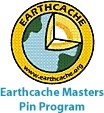
 This outcrop is located behind the wine/gift shop of the
Madonna Inn in San Luis Obispo. Permission has been granted to
visit the site, but degradation, inappropriate activities,
inconsiderate parking, etc. will get this location
archived.
This outcrop is located behind the wine/gift shop of the
Madonna Inn in San Luis Obispo. Permission has been granted to
visit the site, but degradation, inappropriate activities,
inconsiderate parking, etc. will get this location
archived.
Often this rock is referred to as serpentine. However, it is
actually called serpentinite and is made up of serpentine minerals.
It is usually this distinctive bluish-green color, but can range
from apple green to quite dark in other locations. A light and dark
mottling is common. The shiny, waxy look is typical and has a
slippery feel reminiscent of soap.
Up close, serpentinite looks either platy or fibrous depending
upon which of the three most common serpentine minerals make up the
rock. These minerals are lizardite, chrysotile, and antigorite.
Lizardite and antigorite form platy (flat flakes) crystals while
chrysotile forms fibrous (long strands) crystals. Fibrous
chrysotile is the most common form of asbestos.
Serpentinite is a metamorphic rock. But unlike the majority of
metamorphic rocks that form from increased heat and pressure,
serpentinite forms most commonly when peridotite cools, encounters
less pressure, and comes into contact with water. Peridotie is an
igneous rock that is low in silica and high in magnesium and iron.
Rocks having similar chemical composition are called mafic.
Mafic rocks typically form in the earth’s mantle below the
crust. This deep in the earth, the temperature is very high and the
pressure exerted by the overlying rock is very high. The minerals
that form during these conditions are stable only under these
conditions.
As the peridotie is pushed up into the crust at a mid-ocean
spreading center and moves away, the temperature and pressure on
the minerals is reduced. Fractures from plate movement and cooling
rock create conduits for sea water to come into contact with the
peridotie. Another major location where fractures are created is at
subduction zones where the oceanic plate full of peridotie bends,
forming additional cracks, and descends back into the mantle.
It is at subduction zones where serpentinite gets sheared off
the subducting plate and attached to the continental plate. A
subduction zone was present off the coast of California relatively
recently. That is why serpentinite is common in California.
Now that the minerals that make up the peridotie are no longer
in the high pressure and temperature conditions under which they
are stable, they begin to metamorphose. Water is incorporated into
the minerals and they become serpentine minerals turning the
peridotie into serpentinite. The minerals brucite and magnetite are
also formed with the magnesium and iron ions that are left over
along with the release of hydrogen ions. Methane is formed as a by
product of the formation of magnetite. This methamorphic process is
called serpentization.
Serpentization increases the volume of the crystals by about
30%, thus decreasing the density of the rock. This further enlarges
any cracks in the rock allowing more water to come into contact
with unmetamorphosed peridotie, continuing the process deeper into
the rock. This less dense rock begins to work its way up through
more dense material above it, partially explaining how serpentintie
is exposed at the earth’s surface.
Serpentization also creates heat in exothermic chemical
reactions. The chemical reactions are capable increasing the
temperature of the surrounding water by about 260 deg C (550 deg
F). This creates deep undersea thermal vents as hot water is forced
out of sea floor cracks pulling in cooler water. Entire undersea
ecosystems have developed around these vents that are completely
independent of the sun as the heat and food source (methane) is all
derived from the chemical reactions of serpentization. It is
thought that such ecosystems may have been important in the
formation of early life.
Serpentization is also a major factor in the “deep” water cycle.
That is discussed in a The Deep Water Cycle and Serpentininte.
Logging requirements:
Send me a note with :
- The text "GC1GBY3 Serpentinite at Madonna Inn" on the first
line
- The number of people in your group.
- Closely examine the rock at the location and determine the
type(s) of mineral(s) that likely make up the serpentinite
- Feel the rock surface and describe it texture and
feel
The above information was compiled from the
following sources:
- California Geological Survey - CGS Note
41-Guidelines for Reviewing Geologic Reports; Serpentine:
California State Rock;
http://www.conservation.ca.gov/cgs/information/publications/cgs_notes/note_14/Pages/Index.aspx
- Serpentine, Geohiking;
http://www.geohiking.com/serpentine.html
- Ask GeoMan...;
http://jersey.uoregon.edu/~mstrick/AskGeoMan/geoQuerry45.html
- The Deep Meaning of Lost City; A new type of
vent sheds light on a major Earth process; By Andrew Alden,
About.com ;
http://geology.about.com/cs/escibasics/a/aa081003a.htm
- Reaction Sea-water – Mantle: production of
serpentine;
http://www.ifremer.fr/serpentine/english/scientific-sheet-5.htm
- SERPENTINE and SERPENTINITE, USGS,
http://vulcan.wr.usgs.gov/LivingWith/VolcanicPast/Notes/serpentine.html